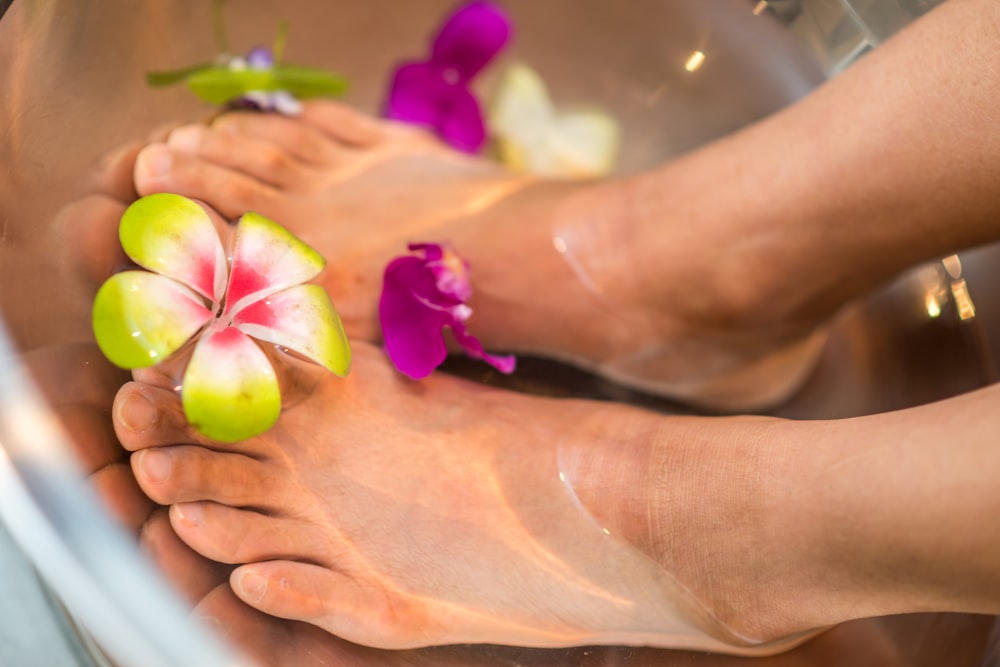
Sandal season is right around the corner, but without proper foot care practices, we won’t have beautiful feet. It’s time to start thinking about how to get “beach ready”. While most of us are very particular when it comes to taking care of our skin, hair, and even our hands, our feet often go ignored for weeks (or months) at a time. If you neglect your feet and forget about your foot care habits, you might start to notice your feet getting in worse condition over time.
While you might not think about your feet much during the winter months when they’re bundled up in socks and boots, the last thing you want is cracked heels and flaky skin when visiting the pool.
Fortunately, there are ways to beautify, soften, rejuvenate and refresh your feet without spending a fortune on salon treatments.
Investing in a little extra foot care won’t just make your feet look beautiful, it could help you to avoid pesky calluses and wayward toenails, too.
Here’s how to get your feet looking and feeling beautiful in time for summer:

1. Consider Foot Peels for “Baby Feet”
Widely regarded as one of the most powerful foot treatments on the market, Baby Feet has taken the world by storm since it launched in 1997. If you haven’t tried this amazing formula yet, and you suffer from dry, cracked, and tough skin on your feet, this could be the perfect solution.
Essentially, the product works by exfoliating and stripping away all of the dead skin on your feet, to leave you with the smooth and soft skin underneath. Named the “original exfoliation foot peel”, Baby Feet uses a combination of unique ingredients to cut through the dry skin building up around your heels and other parts of the foot.
This exfoliation treatment is much more extreme than the kinds you’d get for your face or other parts of the body, because the skin on your feet is thicker, stronger, and capable of tolerating higher strength ingredients. (This is why you can’t ever use Baby Feet on other parts of your body.) You simply apply the Baby Feet solution to your feet, leave it on for two hours, then wash your feet gently with soap.
Water activates the substance, so every day, you should wash your feet to keep it working. Within five to seven days, you should notice the dry skin peeling away.
It’s normal for the skin on your feet to peel off for up to 10 days. Within a couple of weeks you’ll have baby soft feet.
2. Try Foot Moisturizing Socks
If you’re worried about something as harsh as an exfoliation or foot peel treatment, you could try giving your feet an extra-strong moisturizing session instead.
Moisturizing socks are special socks available in two different forms. Some socks simply allow you to apply cream or lotion to your feet in large amounts and leave it there overnight (or for several hours), without it being absorbed.
There are also socks which don’t require the use of any additional moisturizing products. These include specific ingredients such as vitamin E, avocado oil, olive oil, grapeseed oil, and jojoba within a polymer gel on the inside of the sock.
The advantage of the second option is you don’t have to apply creams or lotions yourself, but you will have a limited number of times you can use these socks before the included ingredients run out.

3. Wear the Right Kind of Footwear
You put your feet through a lot each day. The last thing they need is to be shoved into uncomfortable or ill-fitting shoes.
Shoes too tight for your feet are more likely to cause horns and blisters, while loose shoes can cause calloused skin when the shoe starts rubbing against your foot. Make sure you treat your feet to well-fitted shoes, and avoid wearing anything that doesn’t feel great.
It’s also worth giving yourself a break from heels every so often. Even if you feel comfortable in your heels most of the time, they place additional pressure on certain parts of your foot which can lead to all kinds of problems, including a build-up of tough skin.
4. Get Pedicures Regularly as a Foot Care Practice
Speaking of treating your feet, pedicures exist for a good reason. A good pedicure is a fantastic way to get your feet into great shape, because it can tackle everything from buffing away dead skin and removing calluses to keeping your nails in great condition and moisturizing your feet.
Make sure the technician you choose for your pedicure uses the right technique. This means pushing the cuticle back gently rather than cutting it, as cutting can lead to infections and hangnails. It’s also worth removing any nail polishes regularly so you can spot signs of nail infections and problems.
If you’re doing your own pedicure at home, be careful to choose nail clippers with a curved handle and a similar cutting jaw to help follow the natural curve of your nails.
For a boost when you’re getting a little older, consider applying cuticle creams and vitamin E oil to moisturize your toenails and fight back against the brittleness that emerges with age. It’s also worth avoiding polish that’s free from dibutyl phthalate, toluene, and formaldehyde, as these ingredients can all harm your nails.
5. Enjoy a Regular Foot Soak
Few things are better for tired, aching feet than a nice long soak. Most of the best pedicures and foot treatments will start with a foot soak, and you can even create your own foot soak at home for at-home foot care.
Fill a basin or the bottom portion of your bathtub with warm (not hot) water. If the water is too hot it could irritate your skin. You can then add ingredients designed to soften skin, such as:
- Lemon juice: Lemon juice is excellent for removing dead skin cells
- White vinegar: White vinegar can neutralize odors and help with healing cracked feet
- Epsom salts: Epsom salts have fantastic skin healing properties and help with foot pain
- Honey: Honey helps to banish bacteria and moisturize your skin
- Essential oils: Essential oils can help relax and moisturize skin. Try some chamomile
- Baking soda: Baking soda exfoliates skin and reduces itching, while helping with cleansing
Give yourself a relaxing foot soak once a week and pat your feet dry with a soft towel when you’re done. Add moisturizer after about 3 minutes of your feet being in the water to lock in the moisture. Not only will you pamper your feet, but you’ll feel more relaxed too.
6. Use a Pumice Stone (or Foot File) Regularly
When it comes to foot care practices, regularly using a pumice stone will keep your feet looking beautiful. If you spend a lot of time on your feet, they’re eventually going to start forming calluses and thick, cracked sections of skin. Making a habit out of using a pumice stone or foot file will improve your chances of pretty feet when wearing open-backed shoes.
For the best results, work on your feet after soaking them in a bath of water for about 15 minutes. The water will help to soften the skin, so the pumice stone can more easily remove dead cells. A particularly great way to loosen skin is to add some black tea to your bath, as the tannic acid will help to cut through dry skin, while also working as an antibacterial to reduce the risk of athlete’s foot.
You could also boost the quality of your smoothing session with a foot scrub made from botanicals such as sugar, fruit pits, and certain chemical exfoliators. Use a foot cream or palm containing cocoa butter or shea butter to lock in moisture after scrubbing.
7. Invest in the Right Foot Cream
Because the skin on your feet is different to the skin on your face, arms, and chest, it needs a special kind of moisturizing treatment. If you have very cracked or dry feet, you may even need to speak to a podiatrist or dermatologist for insights into which products to use.
Medicated heel pads, which you can access over the counter, can soften calluses as you walk throughout the day. You can also look for extra-strong creams containing petrolatum, lactic acid, or emollient to draw moisture into the skin.
Coconut oil can be an excellent moisturizer for cracked and dry feet. However, you’ll need to make sure you keep the oil on your feet for as long as possible to give it a chance to soak in properly.

8. Wear Natural Materials
Though some socks are specifically designed for moisturizing your feet, including the ones we mentioned above, most everyday socks can be quite drying for problematic feet. Synthetic materials in your socks could mean your feet can’t breathe as well as they should. This could lead to a greater risk of athletes foot and fungus.
Look into buying socks made exclusively of natural materials such as wool and cotton. This will help to keep your feet clean and dry through the day.
It’s also best to avoid socks too tight for your feet. Although most socks are “one-size-fits-all”, anything too tight for your feet will reduce circulation and lead to problems with dryness, discomfort, and fatigue.
9. Try Paraffin Wax
Paraffin wax is another of the substances you might have encountered for your feet during a professional pedicure. The substance helps to soften the skin of hands, feet, and cuticles. This unique substance can also be helpful at dealing pain in people with fibromyalgia and osteoarthritis.
You can purchase portable paraffin wax baths from various retailers online, which help to ensure the temperature of the wax never exceeds dangerous levels. There are also special paraffin wax kits available if you’re going to perform your treatment at home.
Once your wax bath has started to cool, wrap your feet in a towel to keep the heat on your feet for as long as possible. The result should be super soft toes and heels!
10. Massage Your Feet
Finally, if you really want to treat your feet and keep them looking and feeling great, foot massages can be a great addition to your foot care routine. Similar to the rest of your body, your feet need plenty of good circulation to perform at their best. Start by applying an emollient moisturizer to your feet to boost hydration.
Gradually massage your feet as you apply your foot cream or lotion, stretching the tendons in your arches and toe joints as you go. This will help to minimize issues associated with plantar fasciitis. You can find videos online to help with the massage process.
Following your lotion application, put on a pair of socks or even wrap your feet in plastic with some Vaseline on the skin to help boost moisturization even further.
Treat Your Feet to Great Foot Care
Your feet go through a lot every day. It’s worth treating your feet with the same care and attention you would any other part of your body. In fact, your feet (because of what their job is) deserve more care than many other parts of your body.
Treating your feet to good foot care using the above tips will help you have feet that look and feel great. These foot care practices also help reduce your risk of dry and cracked skin ruining your vibe when you hit the beach. Don’t forget, you can get some extra insights into your genetic skin traits within the CircleDNA app after getting your DNA test results.
Due to their genetics, some people have skin issues on their feet or thicker and dryer skin on the feet than most people. To fight your genetics, you’d have to engage in these foot care practices more often than other people, but it’s worth it to have beautiful and soft feet that aren’t uncomfortable or calloused.







Comments are closed.